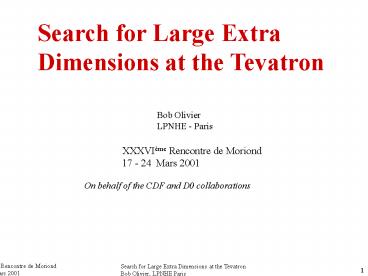Calibration and Databases - PowerPoint PPT Presentation
1 / 17
Title:
Calibration and Databases
Description:
passing basic EM ID criteria. No other kinematic restrictions in the ... (jet fake a g) [Landsberg & Matchev, PRD 62, 035004 (2000)] 7 ... – PowerPoint PPT presentation
Number of Views:33
Avg rating:3.0/5.0
Title: Calibration and Databases
1
Search for Large Extra Dimensions at the Tevatron
Bob Olivier LPNHE - Paris
XXXVIème Rencontre de Moriond 17 - 24 Mars 2001
On behalf of the CDF and D0 collaborations
2
Signatures for Large Extra Dimensions at the
Tevatron
Real Gravitons
- Single Energetic jet
- Missing Energy from the graviton
- Single Vector Boson
- Missing Energy from the graviton
- ? CDF and D0 analysis on going...
Virtual Gravitons
- Fermion or Vector Boson pairs
- ? New Results from D0 !
3
Effects of Virtual Graviton Exchange at the
Tevatron
- In models with Large Extra Dimensions,
Kaluza-Klein gravitons can modify
difermion/diphoton production in
collisions
? interference between SM and gravity
contribution (e.g., ll- production)
- difermion/diphoton production angle
- M difermion/diphoton mass
- n number of large extra dimensions
- MS cut-off scale for KK-diagrams
? search for deviations in distributions for
and M
4
Search Strategy at DØ
- Based on Cheung/Landsberg PRD 62, 035004 (2000)
- DØ detector does not have a central magnetic
field, hence cannot measure electric charge of
electrons - ? use cos?
- Dimuon mass resolution at high mass is poor
- ? use dielectrons, do not use dimuons
- EM objects not separated into electrons and
photons - Low background expected at high mass use loose
EM-ID cuts - ? maximize EM efficiencies
- use EM cluster direction to pick vertex
- ? better and M resolutions
5
Data Selection and Efficiency
- Use entire Run I luminosity, low-threshold,
- di-EM triggers ?Ldt 127 ? 6 pb-1
- Offline criteria
- Exactly 2 EM clusters, ET gt5 GeV,
- passing basic EM ID criteria
- No other kinematic restrictions in the
- analysis, since (M, ) define the
- process completely
- Resulting data sample contains 1250 events
- Overall Signal efficiency 79 ? 2
of events
Criterion
87,542
Starting sample
82,947
Quality criteria
82.927
?2 EM
82,425
2 EM
36,409
ET gt 25 GeV
30,585
Acceptance
10,711
EM ID
1,250
ET gt 45 GeV
6
Backgrounds
- SM backgrounds in the MC
- Drell-Yan (e-pairs)
- qq ? gg (gg ? gg is negligible
- ? not included)
- Wj/ g ,WW, Top, Z negligible
At high mass, SM background dominated by qq ? gg
s, fb/bin
Total SM background
qq ? gg
Landsberg Matchev, PRD 62, 035004 (2000)
gg ? gg
M(di-EM), GeV
- Instrumental background
- QCD induced jj/jg ? gg
- (jet fake a g)
7
MC Description of Data and Systematics
- Kinematic distributions are well described by the
sum of SM and instrumental backgrounds - Following systematic uncertainties on
differential cross sections were taken into
account
Uncertaint
Source
10
K-factor
5
Choice of PDF
4
?Ldt
3
Efficiency
12
Overall
Instrumental background (uncertain to 25)
8
- Observe good agreement in
9
Mass and Angular Distributions
Instrumental background
10
Monte Carlo for Signal and Background
11
DØ Results in Di-EM Channels
- High mass and small cosq are characteristic
signatures of LED - 2-dimensional analysis resolves LED from
high-mass and large cosq tail from QCD
diphotons - No excess seen at high mass, where LED signal is
expected
signal
background
12
DØ Limits on Large Extra Dimensions
- No evidence for SM deviations in D0 data
- Measured fitted with parametrized
contributions from large extra dimensions - Fit result consistent with 0, extracts limits at
95 C.L. - Complementary to those from LEP2
- (0.7 - 1.0 TeV), probing different range of
energies - CDF pursues similar dilepton and diphoton
analyses - (similar sensibility expected)
- Combined Tevatron limits are expected to be the
most restrictive to date
PRL 86, 1156 (2001)
- Sensitivity is limited by statistics reach in
terms of MS will double in Run-2a (2 fb-1) and
triple in Run-2b (20 fb-1)
13
Highest-Mass Candidate
M(gg) 574 GeV cosq 0.86
Event with highest mass observed in Run I
2 photons with Et 81 GeV Met 15 GeV
- Parameters of the candidate event
of highest mass
14
Monojet Signatures
n 2, MS 1 TeV, ?s 1.8 TeV CDF sensitivity
study in progress
Typical process
- Single jet
- Missing energy
- from the
- graviton
15
Real Graviton Signature (CDF)
- Sensitivity on transverse
- mass (jet, Etmiss) for
- different values of n
- CDF analysis on going
16
Summary
- DO has searched for contributions from virtual
graviton exchange in the context of large
extra spatial dimensions. On the basis of the
production of massive e-pairs and di-photons,
such a scale, must be higher than 1 TeV - More studies are being pursued at both DO and
CDF, both on virtual-graviton exchange as well as
real graviton (mono-jet) production. Expected
spring 2001. - Run I limits are most stringent up to date
- Run II will be sensitive to scales of 3-4 TeV
- The LHC will be able to access effective Planck
scales of 10 TeV
17
Run II !
- Tevatron Run II has started
- March 1 2001
- One of the first Run II
- events in D0
- A lot of missing energy
- ? new physics ???































